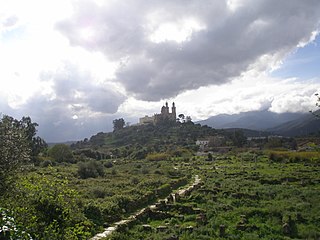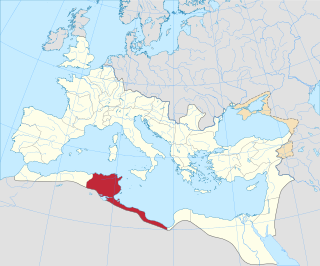Related Research Articles

Huneric,Hunneric or Honeric was King of the Vandal Kingdom (477–484) and the oldest son of Gaiseric. He abandoned the imperial politics of his father and concentrated mainly on internal affairs. He was married to Eudocia, daughter of western Roman Emperor Valentinian III (419–455) and Licinia Eudoxia. The couple had one child, a son named Hilderic.

Gelimer, King of the Vandals and Alans (530–534), was the last Germanic ruler of the North African Kingdom of the Vandals. He became ruler on 15 June 530 after deposing his first cousin twice removed, Hilderic using the pretext of his defeat against the Moorish Chieftain Antalas of the Frexes tribe also Hilderic had angered the Vandal nobility by converting to Chalcedonian Christianity so they promptly went against him, as most of the Vandals at this time were fiercely devoted to Arian Christianity.
Pope Felix III was the bishop of Rome from 13 March 483 to his death. His repudiation of the Henotikon is considered the beginning of the Acacian schism. He is commemorated on March 1.

Hippo Regius is the ancient name of the modern city of Annaba, Algeria. It historically served as an important city for the Phoenicians, Berbers, Romans, and Vandals. Hippo was the capital city of the Vandal Kingdom from 435 to 439 AD. until it was shifted to Carthage following the Vandal capture of Carthage (439).
Parthenia was a Roman–Berber town in the former Roman province of Mauretania Sitifensis, the easternmost part of ancient Mauretania. It was located in what is now northern Algeria.

Karl Felix Halm, was a German classical scholar and critic.

Oea was an ancient city in present-day Tripoli, Libya. It was founded by the Phoenicians in the 7th century BC and later became a Roman–Berber colony. As part of the Roman Africa Nova province, Oea and surrounding Tripolitania were prosperous. It reached its height in the 2nd and 3rd centuries AD, when the city experienced a golden age under the Severan dynasty in nearby Leptis Magna. The city was conquered by the Rashidun Caliphate with the spread of Islam in the 7th century and came to be known as Tripoli during the 9th century.

The sack of Rome in 455 AD marked a pivotal moment in European history when the Vandals, a Germanic tribe led by King Genseric, invaded the city. The Vandals pillaged the city for two weeks, causing widespread destruction. The event, following the Visigothic sack of 410, shocked the Roman world and symbolized the decline and impending fall of the Western Roman Empire.

Saint Eugenius of Carthage was a Christian saint, unanimously elected Bishop of Carthage in 480 to succeed Deogratias. He was caught up in the disputes of his day between Arianism and mainstream Christianity.

Julia of Corsica, also known as Julia of Carthage, and more rarely Julia of Nonza, was a virgin and martyr who is venerated as a saint. The date of her death is most probably on or after AD 439. She and Devota are the patron saints of Corsica in the Catholic Church. Julia was declared a patroness of Corsica by the church on 5 August 1809; Devota, on 14 March 1820. Both were martyred in pre-Christian Corsica under Roman rule. Julia's feast day is 23 May in the Western liturgical calendar and 16 July in the East.
The Notitia provinciarum et civitatum Africae is a Byzantine-era document listing the bishops and sees in the Roman provinces of North Africa, Sardinia and the Balearics. The cause of its preparation was the council of Carthage held on 1 February 484 by the Arian king of the Vandals, Huneric (477–484).

Quiza also known as Vuiza (Βούϊζα), which Pliny the Elder called Quiza Xenitana, was a Roman–Berber colonia, located in the former province of Mauretania Caesariensis. The town is identified with ruins at Sidi Bellater, Algiers.

The Vandal Kingdom or Kingdom of the Vandals and Alans was a confederation of Vandals and Alans, which is one of the barbarian kingdoms established under Gaiseric, a Vandal warrior. It ruled in North Africa and the Mediterranean from 435 to 534 AD.

Simminensis is an ancient and titular episcopal see of the Roman province of Africa Proconsularis in modern Tunisia, and a suffragan diocese of the Archdiocese of Carthage.

Vita was a Roman–Berber civitas in Africa Proconsularis. It is a former Christian diocese and Latin Catholic titular see.

Abbir Maius also known as Abbiritanus was a Roman and Byzantine-era civitas (city), later municipium, in the Roman province of Africa proconsularis.
Theudalis, also known as Teudali, was a Roman era civitas (town) of the Roman province of Africa Proconsularis. The ancient city is tentatively identifiable with ruins at Henchir-Aouam in Tunisia.

Foratiana was an ancient Roman-Berber city in the province of Byzacena and Africa Proconsularis in the Sahel region of Tunisia.
Voncariana was an ancient Roman–Berber civitas in the province of Mauretania Caesariensis. Its stone ruins are located at Boghasi in modern Algeria.

The Kingdom of the Aurès was an independent Christian Berber kingdom primarily located in the Aurès Mountains of present-day north-eastern Algeria. Established in the 480s by King Masties following a series of Berber revolts against the Vandalic Kingdom, which had conquered the Roman province of Africa in 435 AD, Aurès would last as an independent realm until the Muslim conquest of the Maghreb in 703 AD when its last monarch, Queen Dihya, was slain in battle.
References
- 1 2 Victor of Vita (1992). History of the Vandal Persecution. Translated by John Moorhead. Liverpool: Liverpool University Press. pp. xv. ISBN 0-85323-127-3.
- ↑ Victor of Vita (1992). History of the Vandal Persecution. Translated by John Moorhead. Liverpool: Liverpool University Press. pp. xvii. ISBN 0-85323-127-3.
- ↑ Shanzer, Danuta (2004). "Intentions and Audiences: History, Hagiography, Martyrdom, and Confession in Victor of Vita's Historia Persecutionis". In Merrills, A.H. (ed.). Vandals, Romans and Berbers: New Perspectives on Late Antique North Africa. Aldershot: Ashgate Publishing Limited. pp. 272–273. ISBN 0754641457.
- ↑ Shanzer, Danuta (2004). "'Intentions and Audiences: History, Hagiography, Martyrdom, and Confession in Victor of Vita's Historia Persecutionis'". In Merrills, A.H. (ed.). Vandals, Romans and Berbers: New Perspectives on Late Antique North Africa. Aldershot: Ashgate Publishing Limited. p. 278. ISBN 0754641457.
- ↑ Wickham, Chris (2009). "Chapter 4". The Inheritance of Rome: A History of Europe from 400 to 1000. Penguin UK. ISBN 978-0-14-190853-3.
- 1 2 Merrills, A. H. (2010). The Vandals. Miles, Richard. Chichester, U.K.: Wiley-Blackwell. p. 185. ISBN 9781405160681. OCLC 426065943.
- ↑ "Migne Patrologia Latina - Rerum Conspectus Secundum Volumina Collectus".